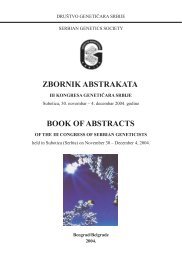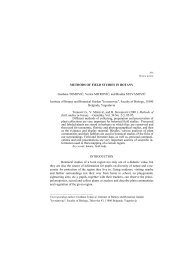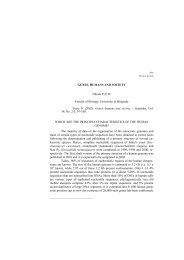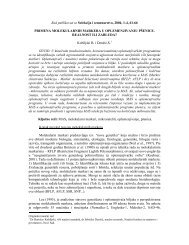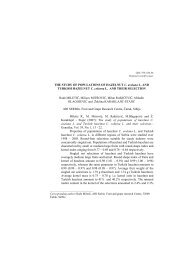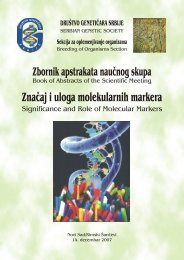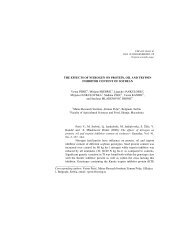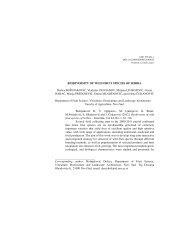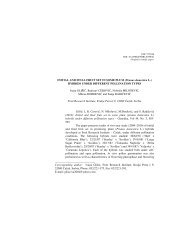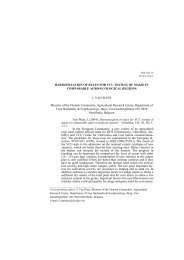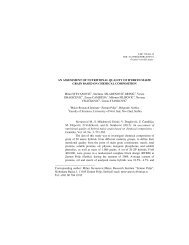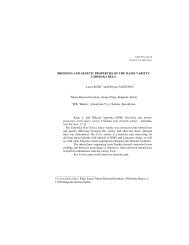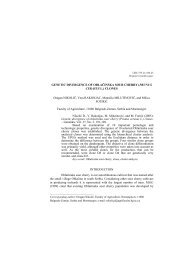Genetic and phenotypic variability of cherry plum (Prunus cerasifera ...
Genetic and phenotypic variability of cherry plum (Prunus cerasifera ...
Genetic and phenotypic variability of cherry plum (Prunus cerasifera ...
Create successful ePaper yourself
Turn your PDF publications into a flip-book with our unique Google optimized e-Paper software.
UDC 575.21<br />
Original scientific paper<br />
GENETIC AND PHENOTYPIC VARIABILITY OF CHERRY PLUM<br />
(PRUNUS CERASIFERA EHRH.) POMOLOGICAL CHARACTERISTICS<br />
Slavica ČOLIĆ, Gordan ZEC, Dejan MARINKOVIĆ, <strong>and</strong> Zoran JANKOVIĆ<br />
Institut PKB Agroekonomik, 11213 Padinska Skela, Serbia <strong>and</strong> Montenegro<br />
Čolić S., G. Zec, D. Marinković, <strong>and</strong> Z. Janković (2003):<br />
<strong>Genetic</strong> <strong>and</strong> <strong>phenotypic</strong> <strong>variability</strong> <strong>of</strong> <strong>cherry</strong> <strong>plum</strong> (<strong>Prunus</strong> <strong>cerasifera</strong><br />
Ehrh.) pomological characteristics. – Genetika, Vol. 35, No. 3, 155-160.<br />
Cherry <strong>plum</strong> (<strong>Prunus</strong> <strong>cerasifera</strong> Ehrh.) is one <strong>of</strong> the most widely<br />
spread fruit species in our country. The fruits are mostly used for br<strong>and</strong>y<br />
production, <strong>and</strong> the seed is used for rootstock production in fruit culture.<br />
As <strong>cherry</strong> <strong>plum</strong> is resistant to plant diseases <strong>and</strong> pests, chemical protection<br />
is not required. Concerning that, <strong>cherry</strong> <strong>plum</strong> is reach <strong>and</strong> cheap<br />
source for the production <strong>of</strong> healthy food. The objective <strong>of</strong> this research<br />
was the analysis <strong>of</strong> genetic <strong>and</strong> <strong>phenotypic</strong> <strong>variability</strong>, as well as study on<br />
correlation <strong>of</strong> pomological traits <strong>of</strong> 49 <strong>cherry</strong> <strong>plum</strong> genotypes selected<br />
from the native population in Serbia. It was measured that the highest genetic<br />
variance in total <strong>phenotypic</strong> variance was for the fruit height <strong>and</strong><br />
total sugar content. The lowest genetic variance in total <strong>phenotypic</strong> variance<br />
was for the length <strong>of</strong> the stalk <strong>and</strong> dry matter content. The highest<br />
genetic variance coefficient (CVg = 22.93%) was calculated for the total<br />
acid content, although the lowest value <strong>of</strong> genetic <strong>and</strong> <strong>phenotypic</strong> variance<br />
was for the fruit width (CVg = 0.69%; CVf = 0.80%). The highest<br />
coefficient <strong>of</strong> <strong>phenotypic</strong> <strong>and</strong> genetic correlation was calculated between<br />
the weight <strong>and</strong> height <strong>of</strong> the fruit. Native population <strong>of</strong> <strong>cherry</strong> <strong>plum</strong> in<br />
Serbia <strong>and</strong> Montenegro is specific because <strong>of</strong> the extensive <strong>variability</strong> <strong>of</strong><br />
_______________________________<br />
Corresponding author: Slavica Čolić, Institut PKB Agroekonomik, 11213 Padinska Skela,<br />
Sebia <strong>and</strong> Montenegro<br />
tel: 8871-174<br />
e-mail: slavicacol@yahoo.com
156 GENETIKA, Vol. 35, No. 3, 155-160, 2003.<br />
the forms, which is highly important for the selection <strong>of</strong> raw material in<br />
breeding process.<br />
Key words: <strong>cherry</strong> <strong>plum</strong>, <strong>variability</strong>, pomological traits<br />
INTRODUCTION<br />
Cherry <strong>plum</strong> (<strong>Prunus</strong> <strong>cerasifera</strong> Ehrh.) is one <strong>of</strong> the most widely grown<br />
fruit cultures in the native population <strong>of</strong> fruit species in Serbia <strong>and</strong> Monenegro<br />
(PEJKIĆ et al., 1991). The fruits are used mainly for the production <strong>of</strong> br<strong>and</strong>y, <strong>and</strong><br />
the seeds are used for the production <strong>of</strong> nursery rootstock. Sinse <strong>cherry</strong> <strong>plum</strong> is<br />
resistable to plant diseases <strong>and</strong> pests (BOŽOVIĆ <strong>and</strong> JAĆIMOVIĆ, 2003), the chemical<br />
protection is not required. According to that, chery <strong>plum</strong> fruits are reach <strong>and</strong><br />
cheap source for the production <strong>of</strong> biologically healthy food (STANKOVIĆ, 1967).<br />
Native population <strong>of</strong> <strong>cherry</strong> <strong>plum</strong> in Serbia <strong>and</strong> Montenegro contains great <strong>variability</strong><br />
<strong>of</strong> forms (ŠOŠKIĆ, 1966; 1968; MILUTINOVIĆ et al., 1990, 1997; MILETIĆ,<br />
1995; ČOLIĆ, 2001), which is <strong>of</strong> great importance for the selection <strong>of</strong> raw material<br />
in breeding process.<br />
The research goals were to study the <strong>variability</strong> <strong>and</strong> the participation <strong>of</strong><br />
genetic <strong>and</strong> <strong>phenotypic</strong> components in the expression <strong>of</strong> pomological traits <strong>of</strong><br />
<strong>cherry</strong> <strong>plum</strong> fruits, the relationship among the traits, as well as genetic <strong>and</strong> <strong>phenotypic</strong><br />
correlation between the traits tested.<br />
MATERIAL AND METHODS<br />
The researches were performed at the school trial field "Radmilovac",<br />
Faculty <strong>of</strong> Agriculture-Belgrade, during 1996-1997 period. The trial was set up <strong>and</strong><br />
designed on the base <strong>of</strong> completely r<strong>and</strong>omized block system with three replicates.<br />
The following pomological traits <strong>of</strong> 49 <strong>cherry</strong> <strong>plum</strong> selections were studied:<br />
fruit <strong>and</strong> seed weight, fruit height <strong>and</strong> width <strong>and</strong> the length <strong>of</strong> the stalk.<br />
Chemical analyses included the estimation <strong>of</strong> sugar, acid <strong>and</strong> dry matter content.<br />
Experimental data were processed according the methodology <strong>of</strong> analyses<br />
<strong>of</strong> variance <strong>and</strong> covariance (HADŽIVUKOVIĆ, 1991). ANOVA statistical programme<br />
was used for the data processing.<br />
RESULTS AND DISCUSSION<br />
One <strong>of</strong> the first steps <strong>of</strong> studying the <strong>cherry</strong> <strong>plum</strong> population was the estimation<br />
<strong>of</strong> genetic diversity at the same agro <strong>and</strong> pomotechnical conditions. The<br />
<strong>variability</strong> <strong>of</strong> analysed traits was estimated on the bases <strong>of</strong> coefficient <strong>of</strong> variance,<br />
<strong>and</strong> the results are presented in Table 1.<br />
Among pomological traits tested the highest <strong>variability</strong> (26.51%) was recorded<br />
for the fruit weight, which varied from 5.60 to 15.34 g. This is in accordance<br />
with the results presented by STANČEVIĆ et al. (1988), MILETIĆ (1995),<br />
MILUTINOVIĆ et al. (1990; 1997), ŠURLAN-MOMIROVIĆ et al. (1999). Fruit width
S.ČOLIĆ et al.: CHERRY PLUM POMOLOGICAL CHARACTERISTICS 157<br />
was less varied (8.90 %), within the interval <strong>of</strong> 20.70-29.80 mm. Regarding the<br />
components <strong>of</strong> chemical compound, the greatest <strong>variability</strong> (22.93 %) was esimated<br />
for the total acid content, which ranged from 1.21 to 2.97 %; this is in accordance<br />
with the results obtained by PEJKIĆ et al. (1991).<br />
Table 1. Variability <strong>of</strong> <strong>cherry</strong> <strong>plum</strong> pomological traits tested<br />
Trait tested Minimal value Maximal value Mean value Cv (%)<br />
Fruit weight (g) 5.60 15.34 9.86 26.51<br />
Seed weight (g) 0.21<br />
1.02 0.59 25.16<br />
Fruit height (mm) 21.20 28.90 25.02 9.70<br />
Fruit width (mm) 20.70 29.80 25.25 8.90<br />
Length <strong>of</strong> stalk (mm) 12.90 20.80 16.50 13.50<br />
Total sugars (%) 6.64 14.58 8.29 11.39<br />
Total acids (%) 1.21 2.97 1.95 22.93<br />
Dry matter (%) 11.00 15.07 13.03 11.79<br />
The highest participation <strong>of</strong> genetic variance (S 2 g) in total <strong>phenotypic</strong><br />
variance (S 2 f) was found for the fruit height <strong>and</strong> total sugar content. The lowest<br />
participation <strong>of</strong> genetic variance in total fenotypic variance was found for the<br />
length <strong>of</strong> stalk <strong>and</strong> dry matter content. Total acid content had the highest coefficient<br />
<strong>of</strong> genetic variance (CVg = 22.93 %). On the other h<strong>and</strong>, the values <strong>of</strong> coefficients<br />
<strong>of</strong> genetic <strong>and</strong> fenotypic variancy for the fruit width were the lowest (CVg =<br />
0.69 %; CVf = 0.80 %). In accordance with the participation <strong>of</strong> genetic variance,<br />
very high values <strong>of</strong> heritability for the fruit height (h 2 = 0.87), seed weight (h 2 =<br />
0.85), fruit weight <strong>and</strong> width (h 2 = 0.81), total acid content (h 2 = 0.99) <strong>and</strong> total<br />
sugar content (h 2 = 0.95) were calculated. This suggests that <strong>variability</strong> <strong>of</strong> these<br />
traits is highly controlled by genes, which is not the case with the length <strong>of</strong> stalk<br />
<strong>and</strong> dry matter content; the variablity <strong>of</strong> these traits is controlled by the factors <strong>of</strong><br />
natural conditions.<br />
Table 2. Components <strong>of</strong> genetic (S 2 g) <strong>and</strong> <strong>phenotypic</strong> (S 2 f) variance <strong>of</strong> <strong>cherry</strong> <strong>plum</strong><br />
pomological traits <strong>and</strong> heritability in broader sense<br />
Fruit Seed Fruit Fruit Length <strong>of</strong> Total Total Dry<br />
weight weight height width stalk sugars acids matter<br />
S 2 g<br />
S<br />
4.492 0.016 0.045 0.032 0.024 0.97 0.20 0.62<br />
2 f<br />
h<br />
5.524 0.019 0.051 0.039 0.035 0.98 0.21 2.33<br />
2<br />
0.81 0.85 0.87 0.81 0.69 0.99 0.95 0.26<br />
CVg 21.49 6.78 0.80 0.69 0.85 11.88 22.93 6.04<br />
CVf 23.82 7.38 0.89 0.80 1.05 11.94 23.50 11.71<br />
The knowledge <strong>of</strong> the correlation relationship among the observed traits<br />
<strong>of</strong>fers a possibility <strong>of</strong> forming right criterions <strong>and</strong> choices for the correct selection.<br />
According to FALCONER (1983) correlations <strong>and</strong> dependance among the traits are
158 GENETIKA, Vol. 35, No. 3, 155-160, 2003.<br />
due to the effects <strong>of</strong> pleyotropic genes. The coefficients <strong>of</strong> genetic <strong>and</strong> <strong>phenotypic</strong><br />
correlation are presented in Table 3.<br />
Table 3. Coefficients <strong>of</strong> genetic (r g) <strong>and</strong> <strong>phenotypic</strong> (r f) correlation <strong>of</strong> <strong>cherry</strong> <strong>plum</strong><br />
pomological traits tested<br />
Trait tested 8. 7. 6. 5. 4. 3. 2. 1.<br />
Fruit<br />
weight<br />
rg rf -0.10<br />
0.11<br />
0.02<br />
0.02<br />
0.18<br />
0.15<br />
0.60 x<br />
0.23<br />
0.89 xx<br />
0.88 xx<br />
0.99 xx<br />
0.95 xx<br />
0.78 xx<br />
0.68 x<br />
Seed<br />
weight<br />
rg rf -0.10<br />
-0.01<br />
0.01<br />
0.01<br />
0.21<br />
0.15<br />
0.32<br />
0.16<br />
0.76<br />
-<br />
-<br />
xx<br />
0.69<br />
0.76 xx<br />
Fruit height<br />
rg<br />
rf -0.05<br />
0.14<br />
0.02<br />
0.02<br />
0.12<br />
0.10<br />
0.53<br />
0.16<br />
0.83<br />
0.66<br />
-<br />
-<br />
xx<br />
0.81 xx<br />
Fruit width<br />
rg<br />
rf 0.10<br />
0.10<br />
0.01<br />
0.01<br />
0.19<br />
0.17<br />
0.61<br />
-<br />
-<br />
x<br />
Length <strong>of</strong><br />
stalk<br />
Total<br />
sugars<br />
rg<br />
rf rg<br />
rf 0.01<br />
-0.15<br />
0.06<br />
0.06<br />
-0.05<br />
-0.03<br />
-0.60<br />
-0.30<br />
-0.18<br />
0.28<br />
-<br />
-<br />
-<br />
-<br />
x<br />
Total acids<br />
Dry matter<br />
rg rf rg rf -0.05<br />
0.02<br />
-<br />
-<br />
0.34<br />
-<br />
-<br />
-<br />
-<br />
x,xx<br />
- Significant at p = 0.05 <strong>and</strong> 0.01, respectively<br />
Positive genetic correlation is set on 75.0 % pairs <strong>of</strong> traits tested, where <strong>of</strong><br />
28.57 % pairs <strong>of</strong> traits tested had a strong <strong>and</strong> very strong correlation. The greatest<br />
statistical very significant genetic correlation (rg = 0.99) is recorded between the<br />
fruit weight <strong>and</strong> fruit height, while the lowest statistical significant genetic correlation<br />
(rg = 0.60) is recorded between the fruit weight <strong>and</strong> the length <strong>of</strong> the stalk.<br />
Singificantly negative genetic correlation (rg = − 0.60) is recorded between the<br />
total sugar <strong>and</strong> acid contents (Tab. 3.).<br />
Positive fenotypic correlation is defined for 85.71 % pairs <strong>of</strong> traits tested,<br />
where <strong>of</strong> 14.28 % pairs <strong>of</strong> traits tested had a strong <strong>and</strong> very strong correlation.<br />
The greatest statistical very significant <strong>phenotypic</strong> correlation (rf = 0.95) is recorded<br />
between the fruit weight <strong>and</strong> fruit height, while the lowest one (rf = 0.68) is<br />
recorded between the fruit <strong>and</strong> seed weight. Negative, but not significant fenotypic<br />
correlation is recorded for the 14.28 % pairs <strong>of</strong> traits tested.<br />
CONCLUSION<br />
Among the studied pomological traits <strong>and</strong> the components <strong>of</strong> chemical<br />
content, the greatest variance is recorded for the fruit weight <strong>and</strong> total acid content.<br />
High values <strong>of</strong> coefficients <strong>of</strong> heritability for fruit height <strong>and</strong> seed weight, fruit<br />
height <strong>and</strong> width, total acid <strong>and</strong> sugar contents are reffered to the genetically controlled<br />
<strong>variability</strong> <strong>of</strong> these traits, while the length <strong>of</strong> the stalk <strong>and</strong> total acid content<br />
<strong>variability</strong> are controlled by the natural conditions. The greatest positive statistical
S.ČOLIĆ et al.: CHERRY PLUM POMOLOGICAL CHARACTERISTICS 159<br />
very significant coefficients <strong>of</strong> fenotypic <strong>and</strong> genetic correlation are recorded between<br />
fruit weight <strong>and</strong> fruit height. The only negative statistical significant coefficient<br />
is calculated between the total sugar <strong>and</strong> acid contents. High values coefficients<br />
<strong>of</strong> heritability <strong>of</strong> <strong>cherry</strong> <strong>plum</strong> pomological traits could enable the selection<br />
from the wide range <strong>of</strong> genotypes, those specific ones that could contribute to the<br />
improvement <strong>of</strong> the most important economic traits <strong>of</strong> present-day <strong>plum</strong> cultivars<br />
<strong>and</strong> rootstocks.<br />
REFERENCES<br />
Received December 26 th , 2003<br />
Accepted December 29 th , 2003<br />
BOŽOVIĆ Đ. i V. JAĆIMOVIĆ (2003): Otpornost na niske temperature, prouzrokovače bolesti i štetočine<br />
izdvojenih genotipova džanarike (<strong>Prunus</strong> <strong>cerasifera</strong> Ehrh.) u području Gornjeg Polimlja.<br />
Zbornik naučnih radova, 9 (1), 185-191.<br />
ČOLIĆ S. (2001) Genetička osnova varijabilnosti osobina džanarike (<strong>Prunus</strong> <strong>cerasifera</strong> Ehrh.). Magistarska<br />
teza. Poljoprivredni Fakultet. Univerzitet u Beogradu.<br />
FALCONER D.C. (1983): Introduction to quantitative genetics. The Ronald press. New York.<br />
HADŽIVUKOVIĆ S. (1991): Statististički metodi. Poljoprivredni fakultet. Novi Sad.<br />
MILETIĆ R. (1995): Selekcija džanarike (<strong>Prunus</strong> <strong>cerasifera</strong>) na području Timočke Krajine. Jugoslovensko<br />
voćarstvo, 29 (3,4), 17-20.<br />
MILUTINOVIĆ M., E. NENADOVIĆ-MRATINIĆ, <strong>and</strong> R. HORVAT (1990): Variability <strong>of</strong> mirabelle<br />
<strong>Prunus</strong> <strong>cerasifera</strong> L. XXIII Inter. Horticult. Congress. Firence. Italy. Poster, abstr. 4011.<br />
MILUTINOVIĆ M., D. NIKOLIĆ, V. RAKONJAC, M.M. MILUTINOVIĆ i M. FOTIRIĆ (1997):<br />
Gen<strong>of</strong>ond džanarike (<strong>Prunus</strong> <strong>cerasifera</strong> Ehrh.) na području Avale. Savremena poljoprivreda,<br />
46 (3,4), 109 – 113.<br />
PEJKIĆ B., M. MILUTINOVIĆ i R. MILETIĆ (1991): Selekcija formi kvalitetnih plodova džanarike<br />
(<strong>Prunus</strong> <strong>cerasifera</strong>) u cilju proizvodnje zdrave hrane. Ekonomika poljoprivrede, 38 (6-7-8),<br />
337- 344.<br />
STANČEVIĆ A., D. OGAŠANOVIĆ i M. NIKOLIĆ (1988): Selekcija džanarike kao voćke široke<br />
mogućnosti gajenja. Nauka u praksi. Zbornik, 2, 91 – 99.<br />
STANKOVIĆ D. (1967): Kvalitetni proizvodi šljive džanarike. Glasnik za poljoprivredu i zadrugarstvo,<br />
7- 8, 45 - 47.<br />
ŠOŠKIĆ A. (1966): Proučavanje raznih tipova džanarike kao podloge za šljivu požegaču. Završni<br />
elaborat za period 1961- 1965. Zavod za voćarstvo i vinogradarstvo. Sarajevo.<br />
ŠOŠKIĆ A. (1968): Research <strong>of</strong> the <strong>Prunus</strong> <strong>cerasifera</strong> Ehrh. in native population in Bosnia. Acta Hort.,<br />
10, 277-289.<br />
ŠURLAN–MOMIROVIĆ G, M. MILUTINIVIĆ, V. RAKONJAC, N. RALEVIĆ, I. RALEVIĆ, <strong>and</strong> D.<br />
NIKOLIĆ (1999): <strong>Genetic</strong> resources <strong>of</strong> <strong>cherry</strong> <strong>plum</strong> (<strong>Prunus</strong> <strong>cerasifera</strong> Ehrh.). Acta Hort.,<br />
484, 123-126.
160 GENETIKA, Vol. 35, No. 3, 155-160, 2003.<br />
GENETIČKA I FENOTIPSKA VARIJABILNOST POMOLOŠKIH<br />
OSOBINA DŽANARIKE (PRUNUS CERASIFERA EHRH.)<br />
Slavica ČOLIĆ, Gordan ZEC, Dejan MARINKOVIĆ i Zoran JANKOVIĆ<br />
Institut PKB Agroekonomik, 11213 Padinska Skela, Srbija i Crna Gora<br />
Izvod<br />
Džanarika (<strong>Prunus</strong> <strong>cerasifera</strong> Ehrh.) je jedna od najrasprostranjenijih<br />
voćaka u spontanoj populaciji naše zemlje. Njeni se plodovi uglavnom koriste za<br />
dobijanje rakije, a seme za proizvodnju podloga u voćarstvu. S obzirom da je<br />
otporna prema izazivačima biljnih bolesti i štetočinama, ne štiti se hemijskim<br />
sredstvima, pa predstavlja bogat izvor i jeftinu sirovinu za dobijanje biološki<br />
vredne hrane. Cilj rada bilo je proučavanje genetičke i fenotipske varijabilnosti i<br />
korelacija pomoloških osobina 49 genotipova džanarike odabranih iz prirodne<br />
populacije Srbije. Najveće učešće genetičke varijanse u ukupnoj fenotipskoj<br />
varijansi ustanovljeno je za visinu ploda i sadržaj ukupnih šećera. Najmanje učešće<br />
genetičke varijanse u ukupnoj fenotipskoj varijansi utvrđeno je za dužinu peteljke i<br />
sadržaj suve materije. Sadržaj ukupnih kiselina odlikovao se najvišim<br />
koeficijentom genetičke varijacije (CVg=22.93 %), dok je vrednost koeficijenata<br />
genetičke i fenotipske varijacije za širinu ploda bila najmanja (CVg=0.69 %;<br />
CVf=0.80 %). Najveći koeficijenti fenotipske i genetičke korelacije zabeleženi su<br />
između mase ploda i visine ploda. Spontana populacija džanarike u Srbiji i Crnoj<br />
Gori karakteriše se velikom varijabilnošću formi, što ima veliki značaj za izbor<br />
početnog materijala u procesu oplemenjivanja.<br />
Primljeno 26. XII 2003.<br />
Odobreno 29. XII 2003.



